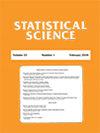利用辅助变量识别主地层内的因果关系
IF 3.4
1区 数学
Q1 STATISTICS & PROBABILITY
引用次数: 16
摘要
在因果推理中,主分层是一个框架,用于处理处理和结果之间的处理后中间变量,其中主分层由中间变量的联合潜在值定义。因为主层不能完全观察到,所以如果没有额外的假设,其中的因果效应,也称为主因果效应,是无法识别的。以前的一些实证研究利用辅助变量来提高对主要因果效应的推断。建立了辅助变量识别和估计主因果效应的一般理论,为统计推断提供了坚实的基础,并为实证研究中的模型构建提供了更多的见解。特别地,我们考虑了主分层问题的两种常用策略:主可忽略性,以及辅助变量与给定主分层和协变量的结果之间的条件独立性。对于这两种策略,我们给出了非参数和半参数识别结果,而没有对结果进行建模假设。当两种策略的假设都不合理时,我们提出了一大类灵活的参数和半参数模型来识别主要因果效应。我们的理论不仅保证了先前实证研究中使用的几个模型的正式识别结果,而且还对它们进行了概括,以允许不同类型的结果和中间变量。本文章由计算机程序翻译,如有差异,请以英文原文为准。
Identification of Causal Effects Within Principal Strata Using Auxiliary Variables
In causal inference, principal stratification is a framework for dealing with a posttreatment intermediate variable between a treatment and an outcome, in which the principal strata are defined by the joint potential values of the intermediate variable. Because the principal strata are not fully observable, the causal effects within them, also known as the principal causal effects, are not identifiable without additional assumptions. Several previous empirical studies leveraged auxiliary variables to improve the inference of principal causal effects. We establish a general theory for identification and estimation of the principal causal effects with auxiliary variables, which provides a solid foundation for statistical inference and more insights for model building in empirical research. In particular, we consider two commonly-used strategies for principal stratification problems: principal ignorability, and the conditional independence between the auxiliary variable and the outcome given principal strata and covariates. For these two strategies, we give non-parametric and semi-parametric identification results without modeling assumptions on the outcome. When the assumptions for neither strategies are plausible, we propose a large class of flexible parametric and semi-parametric models for identifying principal causal effects. Our theory not only ensures formal identification results of several models that have been used in previous empirical studies but also generalizes them to allow for different types of outcomes and intermediate variables.
求助全文
通过发布文献求助,成功后即可免费获取论文全文。
去求助
来源期刊

Statistical Science
数学-统计学与概率论
CiteScore
6.50
自引率
1.80%
发文量
40
审稿时长
>12 weeks
期刊介绍:
The central purpose of Statistical Science is to convey the richness, breadth and unity of the field by presenting the full range of contemporary statistical thought at a moderate technical level, accessible to the wide community of practitioners, researchers and students of statistics and probability.
 求助内容:
求助内容: 应助结果提醒方式:
应助结果提醒方式:


